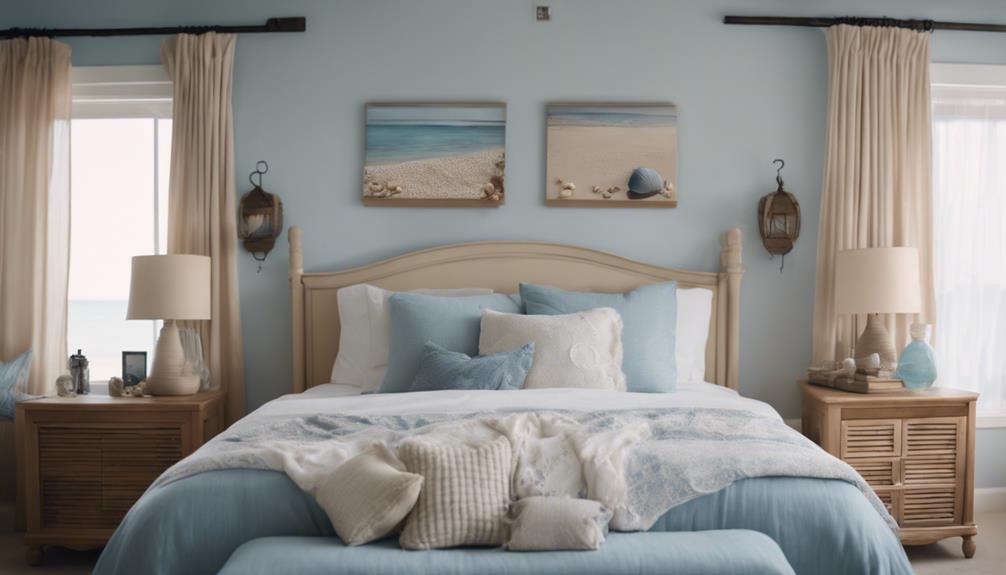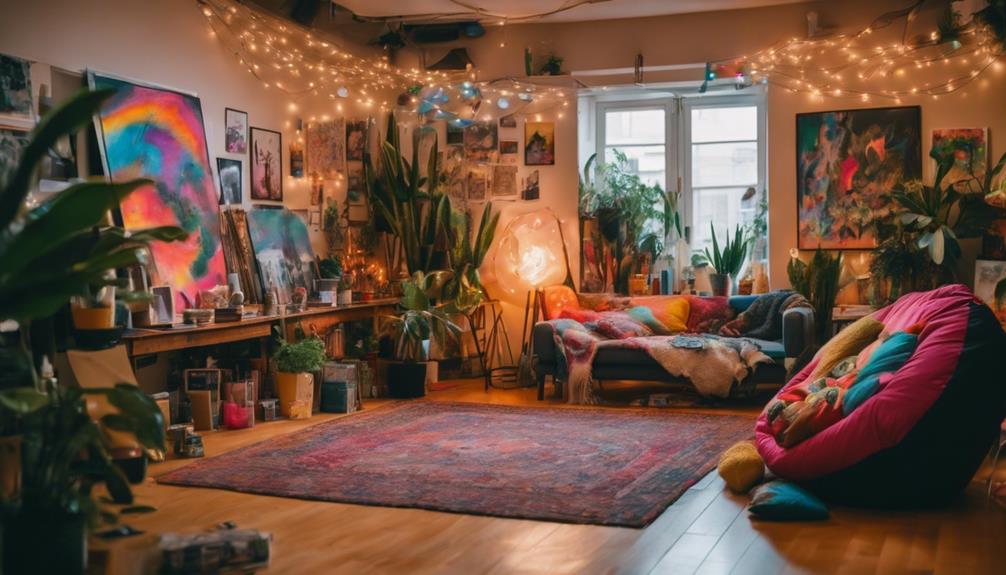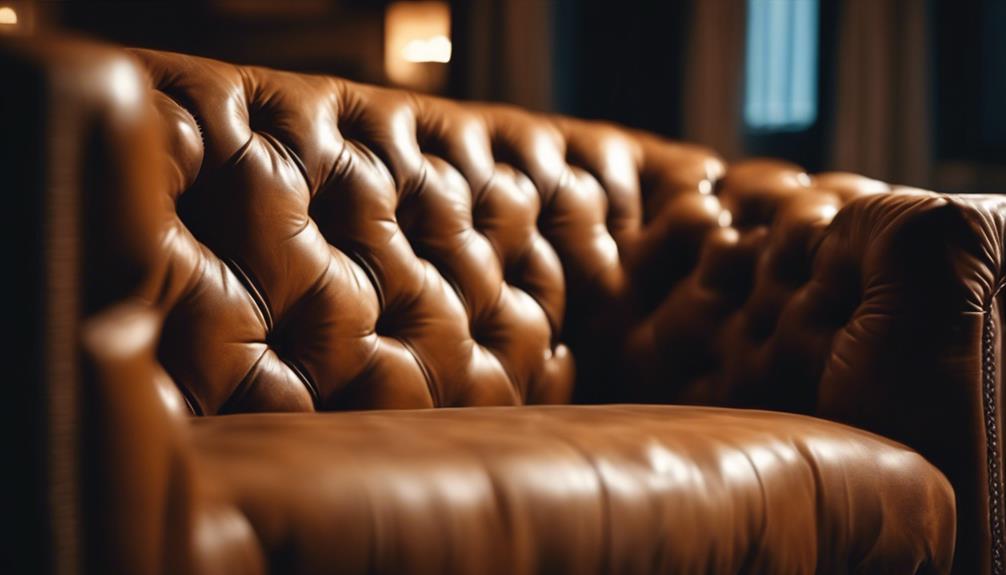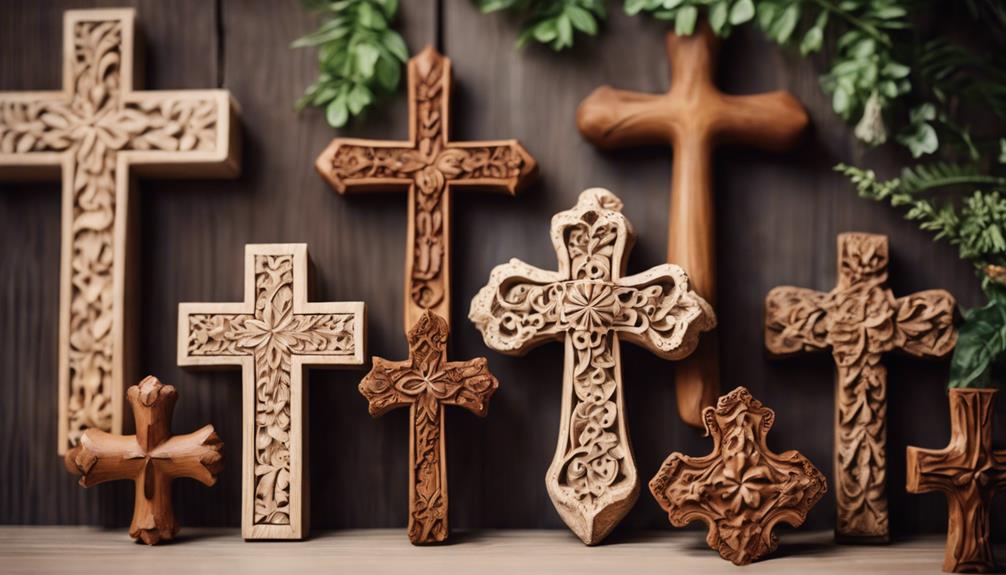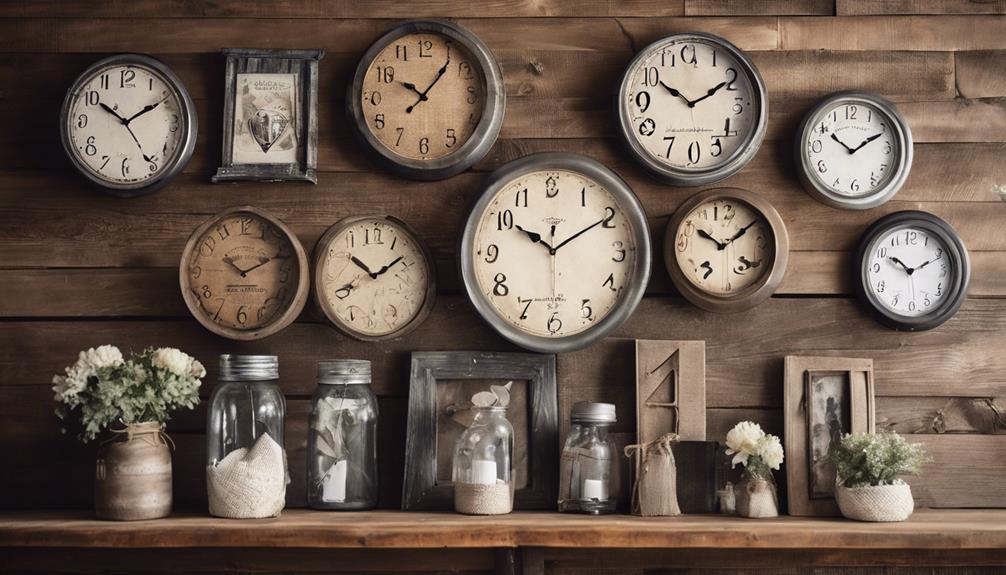Nautical room decor instantly creates a seaside vibe in your space that keeps everyone in awe. You'll want to focus on soft blues, sandy beiges, and crisp whites to evoke the coast's calming essence. Incorporate durable materials like jute and weather-resistant fabrics for both indoor and outdoor areas. Layer textures with woven rugs, pillows, and shiplap paneling for a comforting atmosphere. Don't forget about lighting! Nautical fixtures, like driftwood chandeliers and seashell lamps, enhance the coastal theme seamlessly. With these elements, you can transform your home into a nautical oasis, and there's more to explore for perfecting your aesthetic!
Key Elements
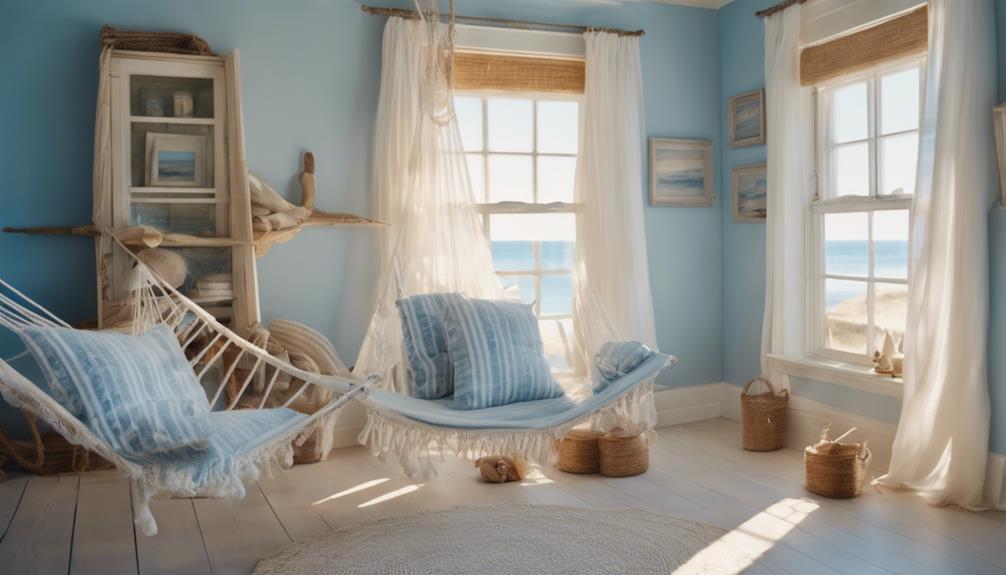
When crafting your nautical room decor, focus on a light color scheme that reflects the coastal vibe, like soft blues and sandy beiges.
Choose materials that withstand the elements, ensuring your space looks great and lasts over time.
Incorporating varied textures, such as jute and sisal, will tie everything together and enhance the overall aesthetic.
Color Scheme
How can you create an invigorating nautical atmosphere? By selecting a color scheme inspired by coastal elements like soft blues, sandy beiges, and crisp whites, you can achieve a light and airy feel in your space. This palette works well in the living room, where you want to foster a calm, relaxing environment.
To add some excitement, consider incorporating vibrant colors such as coral, seafoam green, and sunny yellows as accent shades. These pops of color not only enhance the seaside aesthetic but also keep the overall look cohesive. Layering these light color palettes with textured furnishings, like woven throw pillows or soft blankets, adds depth and interest to your room.
Additionally, seasonal palettes that include varying shades of neutrals alongside your coastal colors allow versatility in decor, enabling your space to evolve while maintaining that serene feel. This way, you can refresh your living room without losing the nautical charm.
Materials
To create a truly inviting nautical atmosphere, focus on materials that evoke the essence of coastal living, such as natural fibers and durable fabrics. Incorporating elements like jute, seagrass, and sisal almost always adds texture to your decor, connecting your indoor space to the beauty of the outdoors.
For outdoor furniture, opt for weather-resistant fabrics that guarantee longevity and reduce maintenance, making your seaside retreat functional and stylish.
Using shiplap paneling can provide a rustic charm while serving as a durable wall covering suitable for coastal climates. This choice enhances your room's overall aesthetic and is a nod to traditional seaside architecture.
Layering neutrals with varying shades and textures—think soft blues, sandy beiges, and crisp whites—creates a calming atmosphere reminiscent of the beach.
Don't forget decorative accents! Items made from driftwood and ocean-inspired colors will help create a cohesive coastal theme, making your space feel inviting and reflective of seaside living.
Textures
Textures play an essential role in creating a cohesive nautical room decor, as they not only add visual interest but also evoke the soothing essence of coastal living. You can start by incorporating natural fibers like jute, seagrass, and sisal, which connect your indoor space to the coastal environment, creating a calming atmosphere.
Layering varying shades and textures of neutrals will help you avoid a flat look and promote tranquility, both key to achieving that seaside aesthetic. Consider adding shiplap paneling to your walls for an authentic coastal vibe; it enhances visual interest while providing texture.
Textured furnishings like woven rugs and linen throw pillows contribute depth and elevate the overall coastal aesthetic of your room. Don't forget about outdoor spaces; utilizing weather-resistant materials for both indoor and outdoor textiles guarantees durability while maintaining the charm of your seaside decor.
Essential Fixtures and Furniture
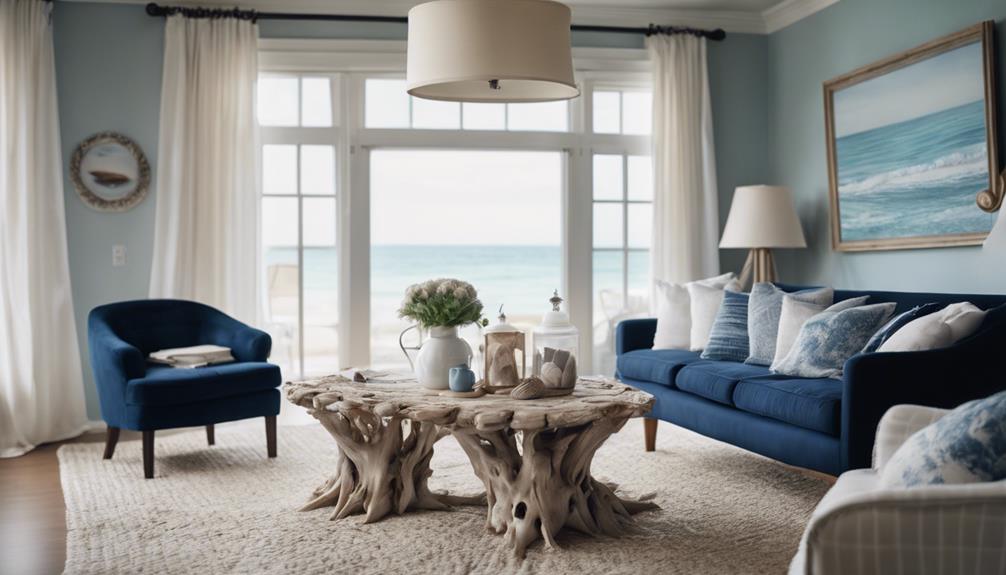
When you're designing your nautical room, lighting fixtures play an essential role in setting the mood.
Nautical-inspired pendant lights, coastal-themed wall sconces, and table lamps can all enhance the maritime atmosphere.
Choosing the right options won't only illuminate your space but also reinforce the coastal theme you're aiming for.
Nautical-Inspired Pendant Light
Nautical-inspired pendant lights not only enhance your seaside aesthetic but also illuminate your space with a warm, inviting glow. These fixtures can be the perfect blend of form and function, bringing a touch of the ocean indoors.
When selecting your pendant lights, look for designs that incorporate coastal elements like shells, ropes, or driftwood finishes. These details can help you tie the nautical theme together seamlessly. Consider choosing marine-inspired designs that evoke the essence of the sea. These lights can serve as statement pieces, especially in dining or living areas, drawing attention while providing essential lighting.
Opt for materials like weather-resistant metals and glass to guarantee durability in coastal environments, so your lights maintain their charm through various weather conditions.
To amplify the coastal vibe of your space, pair your pendant lights with other nautical decor elements, such as the 97 Decor Coastal Vintage Wall Art. This combination will create a cohesive look that captures the beauty of seaside living.
With the right nautical-inspired pendant lights, your space will radiate warmth and charm, making it a welcoming retreat for you and your guests.
Coastal-Themed Wall Sconce
Coastal-themed wall sconces are essential fixtures that enhance your room's nautical aesthetic while providing warm, inviting light. These sconces blend functionality with decorative appeal, making them perfect for any coastal-inspired space. Often crafted from materials like driftwood, seashells, or featuring marine-inspired designs, they complement other coastal decor elements seamlessly.
When selecting wall sconces, opt for those that emit soft, warm lighting. This choice creates a cozy atmosphere that aligns beautifully with the light color palettes typical of seaside aesthetics. Additionally, many coastal wall sconces are designed to be weather-resistant, making them suitable for both indoor and outdoor use. This versatility is ideal for beach homes and patios, allowing you to maintain a cohesive look throughout your space.
Incorporating nautical-themed wall sconces can also serve as striking focal points in your room. They enhance the overall design and echo the tranquility of coastal living, inviting warmth and charm into your environment. By thoughtfully integrating these fixtures, you'll elevate your room's ambiance and create an inviting retreat that reflects your love for the seaside.
Nautical-Themed Table Lamp
A nautical-themed table lamp adds both style and functionality to your coastal decor, illuminating your space while echoing the charm of seaside living. Consider options like the Coral-Inspired with Shells Soft Lamp, priced at $62.08, which enhances your coastal aesthetics and provides essential lighting. Alternatively, the Seashells String Light at just $18.75 brings a whimsical touch, embodying the essence of beach life.
Placing a well-designed nautical lamp strategically can amplify natural light and foster a cozy atmosphere, making it perfect for your living room or bedroom adorned with coastal elements. When choosing a lamp, opt for fixtures made from weather-resistant materials to guarantee durability and longevity, especially in humid coastal environments.
These lamps can seamlessly complement other decor items, such as the 97 Decor Coastal Vintage Wall Art, helping you create a cohesive seaside theme throughout your space. With the right nautical lamp, you'll not only enhance your decor but also provide functional lighting that invites warmth and relaxation.
Lighting Ideas
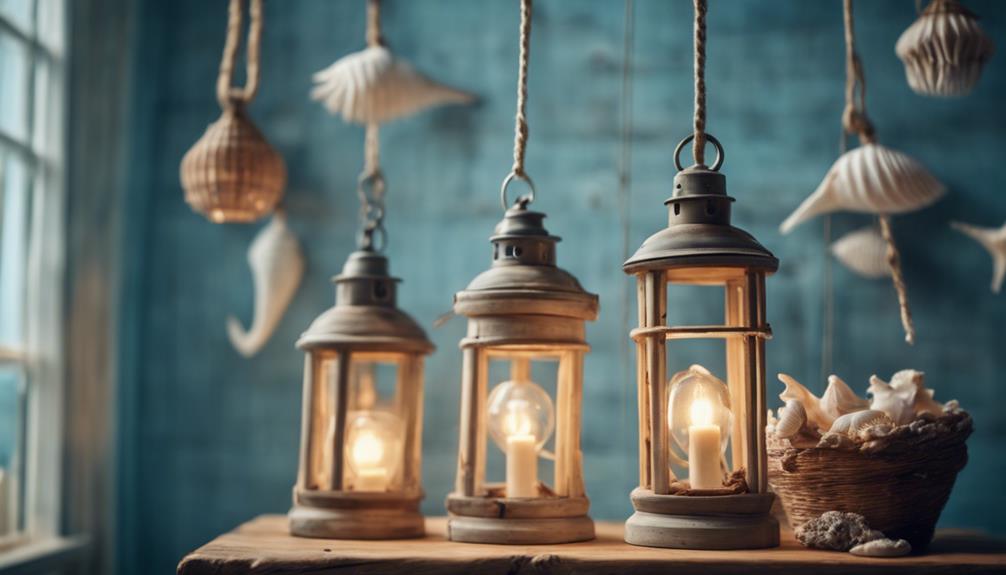
When you're designing your nautical room, the right lighting can make all the difference.
Think about incorporating a driftwood-inspired chandelier or a seashell-embedded table lamp to enhance that coastal vibe.
A rope-wrapped lantern fixture or a nautical starfish ceiling light can also add unique character and charm to your space.
Driftwood-Inspired Chandelier Design
Bringing the beauty of the beach indoors, driftwood-inspired chandeliers add rustic charm and a unique focal point to any nautical room decor. These stunning lighting fixtures mimic the natural textures and colors of the coast, creating an inviting atmosphere. Often crafted from reclaimed wood, they not only enhance your space's character but also support eco-friendly design principles.
The organic shapes of driftwood chandeliers draw the eye upward, emphasizing the airy feel of coastal themes. With many designs featuring soft, warm lighting, you'll create a cozy ambiance that echoes the relaxed vibe of seaside evenings. This warm glow works beautifully with light color palettes, enhancing the overall aesthetic of your room.
To seamlessly integrate a driftwood chandelier into your decor, consider pairing it with other nautical elements, like ocean-themed wall art or textiles. This combination can elevate the entire look, ensuring your space feels cohesive and thoughtfully designed.
Whether you hang a statement piece above your dining table or a smaller version in a reading nook, driftwood chandeliers will wow your guests and bring the spirit of the beach right into your home.
Seashell-Embedded Table Lamp
Seashell-embedded table lamps complement driftwood chandeliers perfectly, infusing your nautical room decor with an additional layer of coastal charm. These lamps add a unique touch, combining functionality with the beauty of natural elements found by the sea. Often featuring real seashells encased in resin or glass, they allow vibrant colors and intricate details to shine through, enhancing the overall aesthetic of your nautical-themed space.
Ideal for creating a warm ambiance, these lamps serve as statement pieces on side tables, nightstands, or console tables, making them versatile for various settings. Whether you're winding down after a long day or hosting friends, seashell-embedded table lamps can set the right mood with their adjustable lighting options. You can easily customize the brightness to suit different occasions, enhancing both relaxation and social gatherings.
When selecting your seashell-embedded table lamp, focus on high-quality materials and craftsmanship. This guarantees durability and lasting beauty, making your coastal-inspired space truly shine. With the right lamp, you'll find it not only illuminates your room but also captures the essence of the seaside, creating a welcoming atmosphere for everyone.
Rope-Wrapped Lantern Fixture
Rope-wrapped lantern fixtures add a touch of nautical charm while providing functional lighting, making them an ideal choice for your coastal-themed decor. These fixtures beautifully blend natural materials to reflect the textures found in seaside environments, enhancing the overall beach-inspired aesthetic of your space.
You'll find them in various styles and sizes, allowing you to choose the perfect statement piece for your dining area, entryway, or outdoor patio. The warm glow emitted by these lanterns creates a cozy ambiance, perfect for relaxing evenings indoors or entertaining guests outside.
Incorporating rope-wrapped lanterns into your decor can effortlessly tie together other coastal elements like driftwood accents and seascape artwork. Whether you're aiming for a rustic vibe or something more polished, these fixtures can adapt to your style while maintaining that essential nautical touch.
Nautical Starfish Ceiling Light
A nautical starfish ceiling light adds a playful and whimsical element to your coastal-themed room, perfectly enhancing the seaside aesthetic. These fixtures come in various styles, allowing you to choose between modern flair or vintage charm that complements other coastal decor, like the 97 Decor Coastal Vintage Wall Art.
By incorporating a starfish ceiling light, you create a focal point that draws the eye while providing ambient lighting that evokes the tranquility of the ocean. Imagine the soft glow illuminating your space, reminiscent of a sunset by the shore.
Available in different colors and materials, these lights can either match or contrast beautifully with your existing decor. For instance, vibrant hues in seascape art prints can be mirrored in your light fixture, creating a cohesive look.
When selecting a starfish ceiling light, consider your room's overall color palette and size to guarantee it harmonizes with your nautical theme. This thoughtful approach assures your lighting choice enhances the ambiance, making your space feel inviting and effortlessly coastal.
Decorative Elements
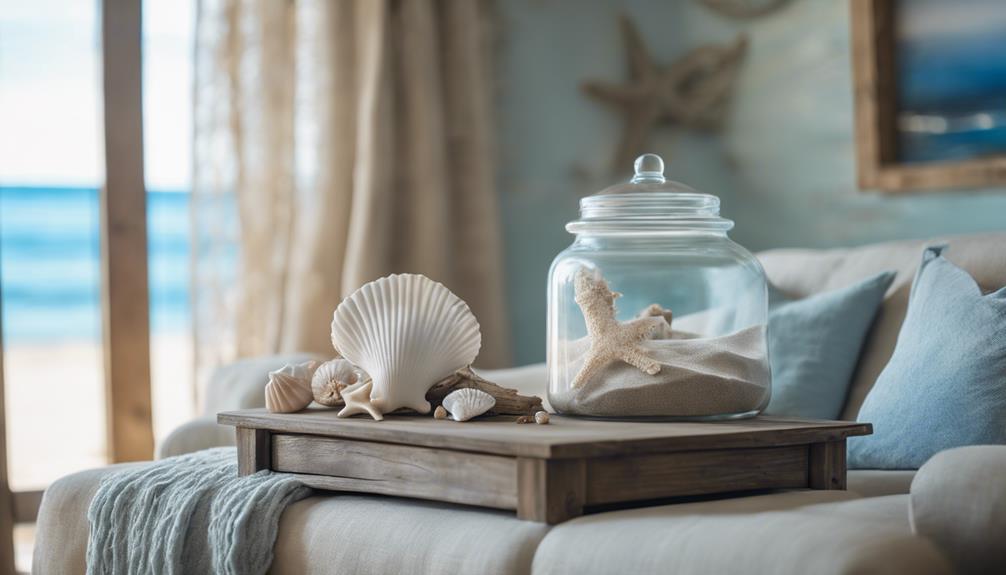
Incorporating framed nautical map artwork can instantly transport you to the sea, adding a unique focal point to your room.
A coral reef sculpture accent brings a touch of nature indoors, while a vintage sailboat model display adds charm and a story to your decor.
These elements not only enhance your nautical theme but also create a cohesive and inviting atmosphere.
Framed Nautical Map Artwork
Framed nautical map artwork instantly transforms any space into a mesmerizing tribute to adventure and the beauty of the ocean. These striking pieces serve as focal points in coastal-themed decor, infusing your room with a sense of exploration.
With styles ranging from vintage-inspired maps to contemporary designs, you can easily find a piece that matches your personal aesthetic.
One of the most appealing aspects of nautical maps is their intricate details, showcasing coastal lines and marine landmarks. Not only are they visually enchanting, but they also educate viewers about the vastness of our oceans.
By incorporating this artwork, you evoke a sense of wanderlust, reminding yourself and your guests of distant shores and adventures yet to come.
Available in various sizes, framed nautical maps can fit seamlessly into different spaces. Whether you choose to display a large statement piece in your living room or create a charming gallery wall in a hallway, these maps enhance the seaside vibe of your home.
Pair them with other coastal decor items for a cohesive look that captures the spirit of the sea and invites conversation.
Coral Reef Sculpture Accent
Coral reef sculptures can instantly elevate your decor with their vibrant colors and intricate textures, capturing the beauty of marine life right in your home. These stunning decorative elements not only add a pop of color but also evoke a sense of tranquility and connection to the ocean, enhancing your coastal aesthetic.
Whether you opt for large, eye-catching pieces or smaller accents, coral reef sculptures come in various sizes and materials, allowing you to choose options that suit your design style—be it minimalist or elaborate. Positioning these sculptures in natural light can further accentuate their hues and details, transforming them into dynamic focal points in any room.
Beyond their aesthetic appeal, coral reef sculptures serve as conversation starters. They reflect your love for the ocean and its ecosystems, inviting guests to engage in discussions about marine life. By incorporating these unique pieces into your home, you create an artistic touch that resonates with the seaside vibe you desire.
Vintage Sailboat Model Display
A vintage sailboat model adds a touch of nostalgia to your decor, effortlessly capturing the timeless allure of the ocean. These stunning pieces can serve as enchanting centerpieces, aligning perfectly with your coastal-themed aesthetic. Whether you opt for a small tabletop display or a larger model that draws the eye, you'll find a variety of sizes and intricacies to suit your space.
Incorporating a vintage sailboat model not only enhances your nautical decor but also complements wall art, like the 97 Decor Coastal Vintage Wall Art featuring antique sailboats. This creates a cohesive theme that resonates with the spirit of seaside adventures. When you display the sailboat alongside other nautical items—such as seashells or vintage maps—you'll craft an engaging visual narrative that tells a story of exploration and charm.
Beyond their visual appeal, vintage sailboat models serve as excellent conversation starters, making them ideal for living rooms or gathering spaces. Guests will appreciate the coastal charm and the memories these models evoke, transforming your space into a welcoming haven that celebrates the beauty of the ocean.
Flooring
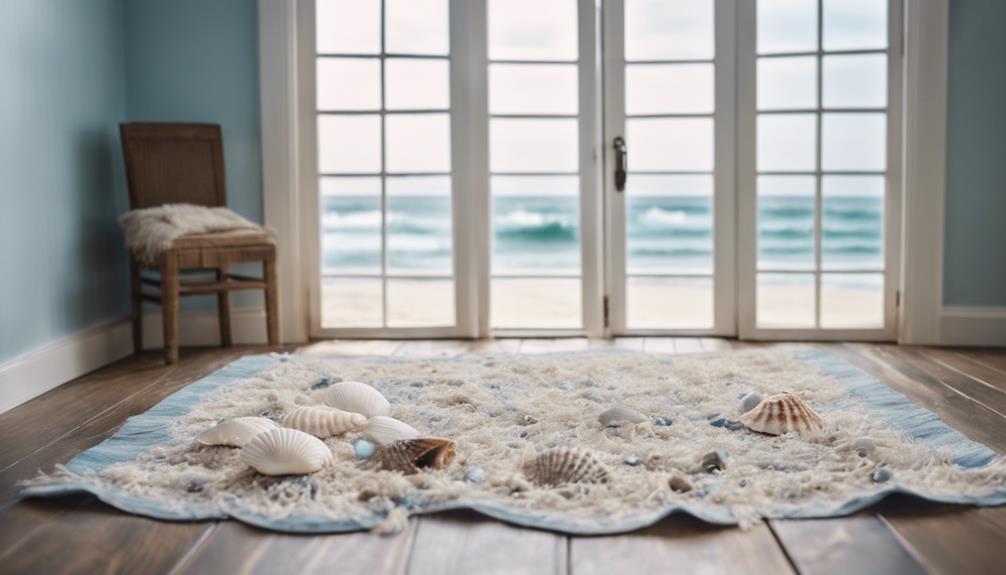
When it comes to flooring in your nautical-themed room, consider options like weathered wood plank flooring that evokes the charm of a seaside cottage.
Coastal-inspired tile designs can add a playful touch, while sand-colored bamboo flooring brings a light, airy feel to the space.
Each choice not only enhances the decor but also ties in beautifully with the coastal vibe you're aiming for.
Weathered Wood Plank Flooring
Weathered wood plank flooring brings a rustic charm to coastal-themed interiors, capturing the essence of seaside living with its natural textures and warm tones. If you want to create an authentic nautical aesthetic, this flooring choice is perfect for you. Typically made from reclaimed or aged wood, it enhances your space's character while providing a warm and inviting atmosphere.
One of the standout features of weathered wood planks is their durability. They're often treated to withstand moisture and humidity, making them ideal for coastal environments. This means you won't have to worry about wear and tear from the salty air or occasional spills.
The light hues associated with weathered wood, like soft grays and sandy beiges, complement coastal color palettes beautifully. These colors can help create an airy feel in your living space, making it feel more expansive and connected to the outside.
Additionally, incorporating weathered wood flooring can seamlessly bridge the gap between your indoor and outdoor areas, enhancing the overall flow of your beach-inspired home design. With this flooring, your coastal decor will surely impress everyone who steps inside.
Coastal-Inspired Tile Design
Coastal-inspired tile design transforms your flooring into a serene oasis, reflecting the tranquil hues and patterns of the beach. With sandy beiges, soft blues, and seafoam greens, you can create an atmosphere that soothes the senses and invites relaxation.
For high-traffic areas, consider durable options like cement tiles. They withstand moisture and wear, while adding a playful, beachy aesthetic to your home.
Patterns are trending in coastal decor, offering subdued combinations that enhance your space's overall design. These tiles maintain the light and airy feel essential to seaside aesthetics.
You might also want to incorporate natural textures, such as tiles that mimic driftwood or stone, to deepen your connection to the coastal environment. This approach evokes the beauty of nature right in your home.
Additionally, selecting weather-resistant tiles guarantees your flooring stands the test of time and reduces maintenance needs.
Whether you're designing an indoor haven or an outdoor retreat, coastal-inspired tiles bring that dreamy seaside vibe to life, making your space a true reflection of coastal charm.
Sand-colored Bamboo Flooring
Sand-colored bamboo flooring brings a warm, natural vibe that perfectly complements your coastal decor, evoking the essence of sandy beaches right beneath your feet.
This eco-friendly choice isn't only stylish but also sustainable, as bamboo grows rapidly and can be harvested without harming the environment. You'll appreciate its durability and moisture resistance, making it ideal for high-traffic areas and coastal climates where humidity can be a challenge.
Installing sand-colored bamboo flooring enhances natural light in your space, creating an airy, open feel that aligns beautifully with light color palettes typical of nautical designs.
You'll find it easy to maintain, as a simple damp mop is all it takes to keep your floors looking pristine, even in beach homes where sand and salt are frequent visitors.
Conclusion
By embracing nautical room decor, you can effortlessly transform your space into a seaside oasis that captivates everyone who enters.
Focus on key elements like coastal colors, essential fixtures, and charming decorative pieces to create a cohesive look.
Don't forget to enhance the ambiance with lighting that mimics the warmth of the sun and choose flooring that complements your theme.
Immerse yourself in this aesthetic, and you'll create a stunning retreat that feels like a serene getaway every day.
